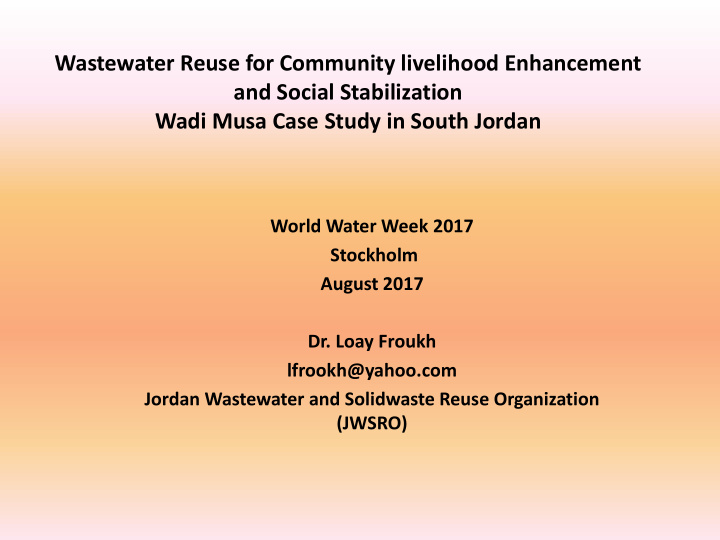



Wastewater Reuse for Community livelihood Enhancement and Social Stabilization Wadi Musa Case Study in South Jordan World Water Week 2017 Stockholm August 2017 Dr. Loay Froukh lfrookh@yahoo.com Jordan Wastewater and Solidwaste Reuse Organization (JWSRO)
Highlights This paper presents a success story for sustainable development project in Wadi Musa south of Jordan Where wastewater reuse from hotels in Petra city is used to promote wastewater reuse in rural areas to alleviate the poverty and create jobs for the local community. In the long run this will to support Jordan wide strategy to encourage beneficial reuse of wastewater with the ultimate goal of protecting the environment and conserving fresh water resources and will contribute to achieve SDG's 1, 2 and 6.
Project Objectives • Water Deficit is around 200 mcm per year • Total treated wastewater is around 140 mcm per year (another source) • Wastewater reuse in Wadi Musa is a landmark water reuse pilot project which aimed at: – Enhancing livelihood in the local community. – Protect health and environment in Wadi Musa area. – improve tourism environment around Petra
Project Summary • The project is located approximately 10 km north of Petra adjacent to Wadi Mousa wastewater treatment plant. • This was the first community based project established in Jordan. Up to 100 hectares is irrigated with reclaimed water for growing fodder crops mainly alfalfa. • In total 80 farmers and their families benefited from this project. Farmers practicing reclaimed water irrigation belong to Sad Al- Ahmar Association. • The local community was provided with technical support from Water Authority to use treated and reclaimed wstewater for irrigation fodder crops. • The water is given free of charge but the farmers pay for operation and maintenance of the conveyance system and distribution network
Success • Utilization of treaded wastewater from Petra hotels contributes to protect tourism environment around Petra . • The yield of the crops is higher by 20-30 % from using freshwater. This is basically due to high nutrients such as N and P in the water. • An additional source of income for the local community members has been secured (700 $ which is more than poverty limit 200 $). • Social stability and gender equality where women and men working in the farms . • Contribution to achieve SDG's: 1 (poverty) , 2 (food security) and 6 (water and sanitation).
Challenges • The main challenge was to control the rise in salinity (some records in recent years reached 1000 ppm). • This affected the efficiency of the irrigation system by 20-30 %. It also affected the booster stations efficiency to drop by 10-20. • High cost of operation and maintenance for the booster pumps, conveyance system, distribution network and equipment. • Marketing skills in a bedwin society
Recommend
More recommend